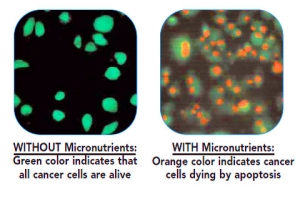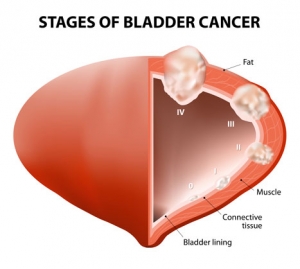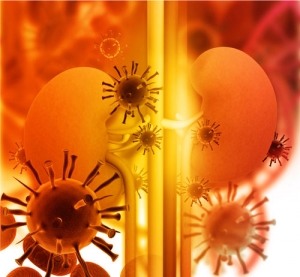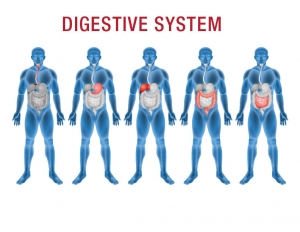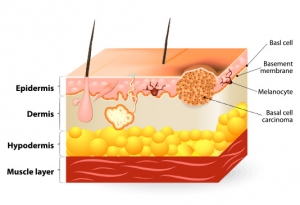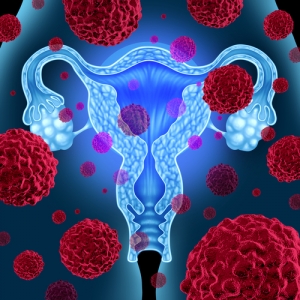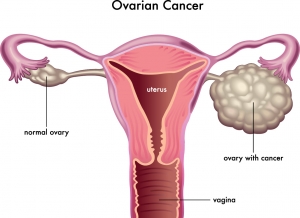Apoptosis, also referred to as “programmed cell death,” or “cell suicide,” originates from a combination of Greek words that can be loosely translated as “falling off.” Apoptosis is a physiological process essential for the development and function of the human body and other multicellular organisms. Millions of cells routinely die in the bone marrow and intestines every hour. It is estimated that approximately 50-70 billion cells die due to apoptosis every day in an average human adult.
Cancer of the urinary bladder is the fourth most common cause of cancer in men. Most bladder cancer patients tend to be older men over the age of 60. The American Cancer Society estimates that in 2015, approximately 74,000 new cases of bladder cancer will be diagnosed in the US.
Kidneys are a part of the urinary system. A pair of fist-sized kidneys is located in the flanks on either side of the vertebral column. The main function of the kidneys is to form urine by removing water and waste products from the body. Urine is then stored in the urinary bladder to be later excreted.
The human digestive system is approximately 16 feet long and it is estimated that the digestive system will process more than 25 tons of food over the course of our lifetime! The function of our digestive system is to convert the foods that we eat into bioenergy for the cells to use for maintenance, growth, and repair. Although we tend to think of the digestive system in terms of organs such as the stomach, intestines, liver and pancreas, these digestive organs are made up of different types of specialized cells.
Skin cancer is the most common of all types of cancers. While melanoma is the most feared skin cancer, non-melanoma skin cancers are far more common. The American Cancer Society estimates 73,000 Americans will be diagnosed with melanoma in 2015; however, there will be 3.5 million new cases of non-melanoma cancers.
The skin is not only the largest organ in the body, it is also a mirror of the health of the body’s internal organs. In addition to protection of inner tissue structures, the skin helps in regulation of body temperature and elimination of metabolic waste products. Many diseases of the digestive, cardiovascular, and nervous systems, and hormonal imbalances and inflammatory conditions are reflected on the skin. With approximately 20 square feet of surface area, the skin is primarily taken care of for cosmetic appeal. Thousands of skin care products cater to beauty and health conscious consumers who hope to avoid acne, discoloration and signs of aging, as well as skin cancer. It is estimated that the global skin care products industry revenue will be $102.3 billion by 2018.
Cervical cancer is the third most commonly diagnosed cancer and the fourth most common cause of death in women. The American Cancer Society estimates 12,900 new cases of cervical cancer will be diagnosed in 2015. Most women diagnosed with cervical cancer are between 30 to 60 years old. While the routine Pap test has reduced cervical cancer deaths in developed countries, it remains a major cause of deaths in women in developing countries. According to 2012 data, approximately 528,000 new cases of cervical cancer were diagnosed worldwide.
Psoriasis is an autoimmune, chronic inflammatory skin disease characterized by thickened, red skin with silvery scaled patches. These patches typically occur on the scalp, elbows, knees, and lower back. Although the exact cause of psoriasis is not clear, it is not a contagious disease. Psoriasis affects 2-3% of the world’s population, and men and women between the ages of 15 and 45 are equally affected.
The ovaries are part of the female reproductive system and are located on each side of the uterus. They are responsible for the storage and release of an egg every month during a woman’s childbearing years, and the production of the hormones estrogen and progesterone. Estrogen and progesterone control the menstrual cycle and pregnancy, and have protective effects on the heart, bones and multiple organ systems in women.
The uterus, commonly referred to as the “womb,” is a hollow and highly expandable organ responsible for accommodating the growing fetus during the nine months of pregnancy. The uterus is made up of strong, involuntary muscles that contract during menstruation and childbirth. Abnormal contractions of the uterine muscles may cause severe cramps during menstruation. During pregnancy, the abnormal and untimely uterine contractions could lead to premature labor and delivery. A normal healthy pregnancy usually lasts up to 40 weeks. If the infant is born before the 37th week of pregnancy, it is termed a “preterm birth.” According to the Centers of Disease Control and Prevention (CDC), 11.4% of the pregnancies in the US ended in preterm delivery in 2013. Preterm delivery is also the cause of approximately 35% of all infant deaths.
